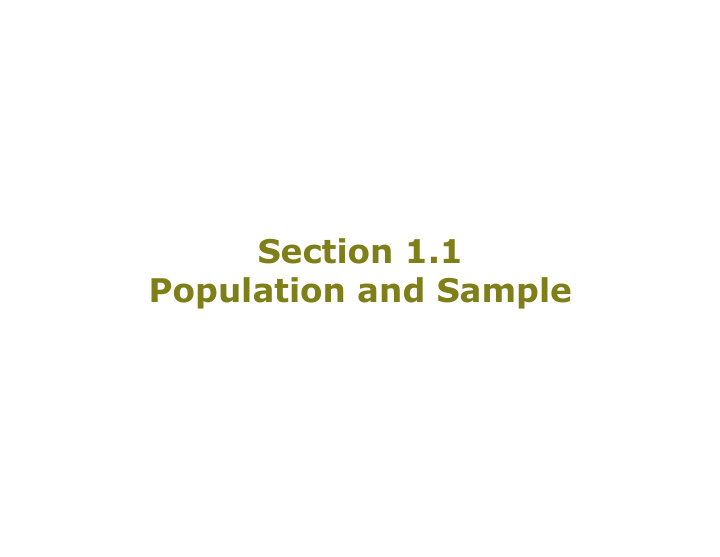



Section 1.1 Population and Sample
WHAT IS STATISTICS? Statistics is a group of methods used to collect, analyse, present, and interpret data and to make decisions.
POPULATION VERSUS SAMPLE A population consists of all elements – individuals, items, or objects – whose characteristics are being studied. The population that is being studied is also called the target population . A portion of the population selected for study is referred to as a sample .
POPULATION VERSUS SAMPLE Definition A survey that includes every member of the population is called a census . The technique of collecting information from a portion of the population is called a sample survey .
Figure 1.1 Population and Sample
POPULATION VERSUS SAMPLE A sample that represents the characteristics of the population as closely as possible is called a representative sample .
Simple random sampling A sample drawn in such a way that each element of the population has a chance of being selected is called a random sample . If all samples of the same size selected from a population have the same chance of being selected, we call it simple random sampling . Such a sample is called a simple random sample .
Methods for Collection of Data n Random Sampling -> STAT 348 n Experimental Design -> STAT 345
An Example of Sample Survey Results We want to answer the following questions: 1) What is the percentage of adults who speed up to beat a yellow light in the whole population? 58%? This is called point estimation problem. 2) What’s an interval that have high confidence to contain the true percentage of adults who speed up to beat a yellow light in the population? 58% +- 2%? This is called interval estimation problem. 3) Is the true percentage of adults who speed up to beat a yellow light in the population smaller than 60%? Yes or no? How confident you are about your claim? This is called hypothesis testing problem.
Inferential Statistics Versus Probability theory
An example Probability theory p = 10% of individuals in a population have label 1 and 90% of individuals have label 0. If we randomly draw three individuals, Inferential statistics A population has individuals with label 1 or label 0. After we randomly draw three individuals, we see that What's the proportion, p , of individuals with label 1? What's your uncertainty in your estimate? Is p < 0.5, or p > 0.5 ?
BRANCHES OF STATISTICS Descriptive Statistics consists of methods for organizing, displaying, and describing data by using tables, graphs, and summary measures. Inferential Statistics consists of methods that use sample results to help make decisions or predictions about the unknowns of a population.
An Example of Descriptive Statistics
BASIC TERMS Definition An element or member of a sample or population is a specific subject or object (for example, a person, firm, item, state, or country) about which the information is collected.
BASIC TERMS Definition A variable is a characteristic under study that assumes different values for different elements. In contrast to a variable, the value of a constant is fixed.
BASIC TERMS Definition The value of a variable for an element is called an observation or measurement . A data set is a collection of observations on one or more variables.
Table 1.1 Charitable Givings of Six Retailers in 2007
TYPES OF VARIABLES p Quantitative Variables n Discrete Variables n Continuous Variables p Qualitative or Categorical Variables
Quantitative Variables Definition A variable that can be measured numerically is called a quantitative variable . The data collected on a quantitative variable are called quantitative data .
Quantitative Variables: Discrete Definition A variable whose values are countable is called a discrete variable . In other words, a discrete variable can assume only certain values with no intermediate values.
Quantitative Variables: Continuous Definition A variable that can assume any numerical value over a certain interval or intervals is called a continuous variable .
Qualitative or Categorical Variables Definition A variable that cannot assume a numerical value but can be classified into two or more nonnumeric categories is called a qualitative or categorical variable . The data collected on such a variable are called qualitative data .
Figure 1.2 Types of Variables
Recommend
More recommend